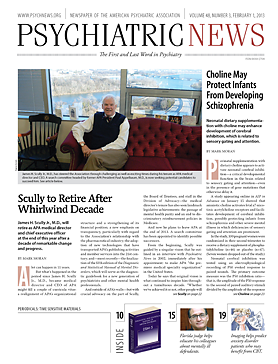Graphics indicating the number and types of ties disclosed by individually named group members depicted each person’s industry-related grant support, research funding, lecture fees, advisory board memberships and other relationships with industry. The article implies that these industry relationships may have influenced the changes that have been made in the DSM-5 diagnosis of major depressive disorder and may increase use of antidepressant treatment among bereaved individuals. In this context, we thought it would be helpful to discuss the process by which we developed the Practice Guideline for the Treatment of Patients With Major Depressive Disorder and the changes that are being introduced into APA’s practice guideline development process.
When the third revision of the major depressive disorder guideline was initiated in 2005, there was increasing dialogue at a national level about the potential role of industry influences on clinical practice and recommendations made by clinical guidelines. Work group members disclosed conflicts as part of the group’s deliberations. The work group and APA’s Steering Committee on Practice Guidelines were aware that industry relationships or individual viewpoints might color recommendations and worked hard to assure that final recommendations were free of such effects and based solely on a careful appraisal of available evidence. By the time the development process had been completed and the major depressive disorder guideline was being readied for publication, there was heightened attention to the potential effects of industry relationships, in part related to the publication of the Institute of Medicine report in 2009 on Conflict of Interest in Medical Research, Education, and Practice. In light of this evolving landscape on conflict-of-interest considerations, the APA Steering Committee on Practice Guidelines took the additional step of appointing a group of well-regarded research and clinical experts in mood disorders to review the guideline recommendations for evidence of industry bias. This independent review committee of experts who had zero industry ties found no evidence for any industry influence in the recommendations.
The treatment recommendations themselves suggest that industry bias was not an issue. The guideline gives equal weight to psychotherapy and antidepressant medications for treating moderate levels of major depression. And, the first-line medications that are recommended for use in major depression include nonproprietary agents whose patents have expired and are available in generic formulations. With bereaved individuals, the guideline notes that normal grief is distinct from major depressive disorder and “should be treated with support and psychoeducation about symptoms and the course of mourning.” However, like other psychosocial stressors, bereavement can trigger a major depressive episode. It is under such circumstances that the guideline recommends treatment “with medication and/or depression-focused psychotherapy.” Between these options, the guideline notes that selecting an initial treatment for major depressive disorder “is influenced by several factors, including the symptom profile, the presence of co-occurring disorders or psychosocial stressors, the patient’s prior treatment experience, and the patient’s preference.”
Since publication of the major depression guideline in 2010, the national views on conflicts of interest and practice guidelines have undergone even more changes. In 2011 the Institute of Medicine published two landmark reports, “Standards for Developing Trustworthy Clinical Practice Guidelines” (
http://www.iom.edu/Activities/Quality/ClinicPracGuide.aspx) and Finding “What Works in Health Care: Standards for Systematic Reviews” (
http://www.iom.edu/Reports/2011/Finding-What-Works-in-Health-Care-Standards-for-Systematic-Reviews.aspx), designed to provide guidance and standards for professional associations and other guideline-writing groups. The recommendations of these reports are aimed at maximizing the “trustworthiness” of practice guidelines and minimizing the potential impact of industry influences on guideline treatment recommendations. Among several dozen specific recommendations, the IOM guidance advises that expert members of a guideline-writing group might in fact have industry ties, but that such ties must be carefully managed. According to IOM standards, individuals with industry ties must constitute less than 50 percent of the members of a guideline-writing group, and neither the chair nor co-chair of these groups should have any industry ties at all.
Anticipating these changes, over the last few years the APA Steering Committee on Practice Guidelines has devoted considerable effort to producing practice guideline development procedures that meet or exceed the IOM recommendations with regard to avoiding industry influences. None of the individuals involved in current or future guideline development efforts have any industry ties. This includes all members of the Steering Committee for Practice Guidelines and the Executive Committee for Practice Guidelines, all members of the current Psychiatric Evaluation guideline-writing group, all members of our systematic literature review group, and all members of the recently appointed and empaneled guideline writing group that will write an assortment of planned forthcoming guidelines. Part of the recommended process for guideline development involves obtaining public comment, and some individuals offering input may have industry relationships. We also anticipate that during guideline development, there may be a need for updated information on ongoing clinical trials or experts’ perspectives on a specific topic. Such individuals may happen to have ties such as research grants with industry, which they will be asked to disclose as part of the commenting process. Furthermore, in line with IOM standards, only the guideline-writing group will write and determine the strength of official guideline recommendations.
Over the past decade, there has been substantial evolution in the national discourse and standards for addressing industry relationships in clinical practice guideline development. During the time that APA’s practice guideline for the treatment of major depressive disorders was written, there was a rapid transition of views about industry ties and other potential conflicts of interest. Despite these shifts in standards for industry relationships, we took multiple steps to assure that treatment recommendations were not influenced by industry biases. We believe that we fully succeeded in that goal, and we stand behind the guideline as representing the best available evidence-based recommendations. The Association has also developed stringent policies and procedures to assure that forthcoming guidelines will meet IOM standards, continuing to assure that our practice guidelines are trustworthy and free of bias. ■

